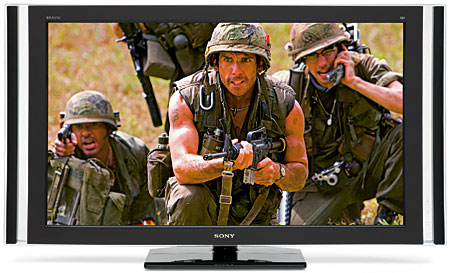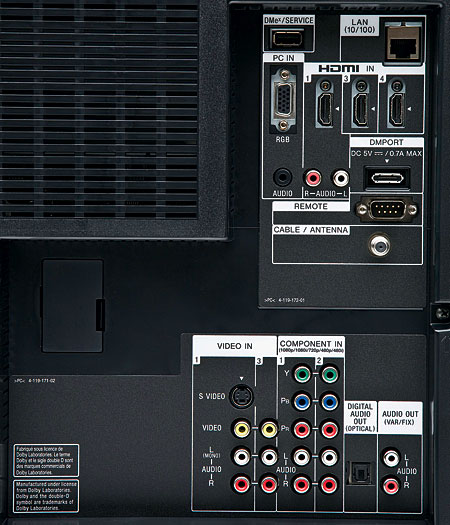Sony BRAVIA KDL-55XBR8 LCD HDTV
Despite the market penetration of LCD flat panels—they significantly outsell plasmas—LCD technology has two serious shortcomings. Off-axis viewing is one—we’ll get to that a bit later. The other is how they handle blacks and deep shadow detail. But a new design technique, LED backlighting with local dimming, promises to change all that. (See sidebar on page 37.) Both the Sony and the Samsung use it.

Sony’s name for this feature is the TRILUMINOS RGB Dynamic LED Backlight. As we explain in more detail in the sidebar, LED backlighting local dimming uses dozens of clusters of red, green, and blue LEDs. (The Sony uses one red, one blue, and two green LEDs per cluster.) The clusters are illuminated individually as required by the image. (Instead of the colored LEDs that Sony uses, Samsung uses white LEDs with color filters.)
But LED local dimming isn’t all that the Sony offers. It has the most extensive list of features of all the sets in the group.
Looking Around
The KDL-55XBR8 offers the usual assortment of inputs, including four HDMI 1.3 and three component video.
Sony’s onscreen menu system, the Xross Media Bar (XMB) guides you through that wide (and sometimes confusing) assortment of controls. There are four Picture modes for video material (and four additional modes for photo viewing): Vivid, Standard, Cinema, and Custom. We conducted our tests in Custom mode after a full calibration.

Apart from the usual suspect video controls, the wide range of other adjustments would take double the space I have here to describe in useful detail. Actually, I’d be mostly describing why I don’t recommend using many of them. However, in the absence of a full calibration, you should simply put the set in Custom mode, adjust the main user controls (Picture, Brightness, Color, Tint, and Sharpness) with the help of a good setup disc like Digital Video Essentials HD Basics (Blu-ray), put the color temperature on Warm2 (leaving all the other controls on default), and hop aboard.
 The Sony operates at a frame rate of 120 Hz. The set refreshes at 120 Hz with processing that adds new interpolated frames to the source’s 24-Hz or 60-Hz frame rate. Sony calls this technology Motionflow 120Hz PRO, and many competing 120-Hz sets operate similarly. With this technology, motion lag—which has long been an issue with LCDs—can be reduced or eliminated. The only issue many of us have with this feature is that it can make film sources look like video. For this test, we shut the feature off. When Motionflow is off, the set simply repeats frames, instead of interpolating them, to reach its native 120-Hz frame rate.
The Sony operates at a frame rate of 120 Hz. The set refreshes at 120 Hz with processing that adds new interpolated frames to the source’s 24-Hz or 60-Hz frame rate. Sony calls this technology Motionflow 120Hz PRO, and many competing 120-Hz sets operate similarly. With this technology, motion lag—which has long been an issue with LCDs—can be reduced or eliminated. The only issue many of us have with this feature is that it can make film sources look like video. For this test, we shut the feature off. When Motionflow is off, the set simply repeats frames, instead of interpolating them, to reach its native 120-Hz frame rate.
When the KDL-55XBR8 receives a 24-fps input, it keeps it as a direct multiple of 24 fps all the way to the screen. That is, the display repeats the original frame five times (or interpolates as needed) to bring it directly up to 120 Hz—a process called 5:5 pulldown.
With the Sony’s CineMotion (film mode) in Auto 1 and DRC off, the set’s component 480i-to-1080p video processing was poor in many respects. But it improved to good with DRC turned to Mode 1. Similarly, the HD (1080i-to-1080p) resolution over HDMI improved from fair (DRC off) to good with both controls on. However, in all cases of both SD and HD, our 2:2 tests (pro- cessing a video-based source) showed a poor result.
The Judges Speak
The panel found the Sony’s deep black levels impressive. They commented that the set was “significantly darker than any other set” on full black images such as a fade to black between scenes. Comments like, “Nothing to criticize at all,” were frequent. The Sony was particularly effective on scenes such as the opening titles in Shakespeare in Love (with the words “London 1530” superimposed over a black background), the night chase in the bottling plant in The Incredible Hulk, and the lighted animal crates (and white eyeballs) suspended in a field of black in chapter 6 of Madagascar. One participant wrote that those eyeballs appeared to float in space on the Sony. Another commented that the Sony was effective on the dark, difficult-to-reproduce scenes from Stargate: Continuum, which includes the star field at the beginning of chapter 1, the ship scenes in chapter 3, and the Russian stargate facility in chapter 21. And another added, “This was the only set I wanted to watch Master and Commander on.”
But this praise was tempered by negative comments on the Sony’s off-axis viewing limitations. One observer saw noticeable false contouring off axis on some of the material (which disappeared on axis). Others found that the black level performance (and color) deteriorated noticeably at small off-axis angles. Nevertheless, the Sony performed so well on axis that it tied with the Pioneer for the best overall black level.
One judge wrote, “I thought the Sony lacked shadow detail in a lot of the darker clips. I noted that it had the least detail. Every aspect of this TV is subject to caveats about viewing angle—off axis, the shadow detail fell off even more (as did color). It had the least shadow detail in Hulk.” Others commented about the lack of various details in dark scenes.
 But the criticism of the set’s shadow detail was not universal. At least two of the judges praised it on some of the program material. And to be fair, all of the sets might have benefited on one piece of program material or another from slight readjustments in their brightness levels or gamma (an unworkable complication for a group test). Nevertheless, the Sony virtually tied the Panasonic for shadow detail. (The Panasonic was only marginally ahead in the raw scores, by one point out of 50—not enough to affect the composite ratings.) If it didn’t have off-axis limitations, the Sony would most certainly have pulled ahead of the Panasonic in this category.
But the criticism of the set’s shadow detail was not universal. At least two of the judges praised it on some of the program material. And to be fair, all of the sets might have benefited on one piece of program material or another from slight readjustments in their brightness levels or gamma (an unworkable complication for a group test). Nevertheless, the Sony virtually tied the Panasonic for shadow detail. (The Panasonic was only marginally ahead in the raw scores, by one point out of 50—not enough to affect the composite ratings.) If it didn’t have off-axis limitations, the Sony would most certainly have pulled ahead of the Panasonic in this category.
There was a noticeable split in our panel of judges over the Sony’s color. Two viewers gave it relatively high marks. In fact, one actually liked its color best and noted that while it looked a bit pale at first, it later “became my favorite for color. Has good balance and is easy to watch (non fatiguing).”
But three others gave the set low enough marks for color to make it last in that category. This was interesting, considering that on the color parameters we measured, the Sony was nearly flawless. The main criticisms were a subtle but noticeable shift to blue-green in color tracking. The fact that the colors faded out noticeably at even small off-axis angles also contributed to the less than stellar results. It was probably no coincidence that the two plasma sets came in first and second for color and the two LCDs came in third (the Samsung) and fourth (the Sony—another virtual tie). On Legends of the Fall, one panelist remarked, “Get that boy a steak.” However, my experience with the two LCD sets and how they fade skintones (in particular) from only a very small off-axis angle suggests that she was viewing the image off axis at the time. Another judge noted, “I can’t say this enough. It’s a different set at different and not very extreme angles.”
But at least one panelist commented on the natural skintones (in Shakespeare in Love). Another remarked, “The color looked a little less realistic, but it probably was the most accurate. Marked down for poor off-axis performance.”
All of the sets here performed well on detail, and the Sony finished second in this category in a strong group. “Great detail,” one of the judges remarked. “Fantastic on all the high-def stuff. Some motion blur.” Others commented on the good video processing, both in standard definition and high definition, remarking on the clean pan across the thatched roof in the opening scene of Shakespeare in Love (SD). Another gave it the nod for best deinterlacing performance in the Mission: Impossible III tests (1080i). Its excellent detail overall may have contributed to several comments about subtle noise or grain on some of the material, but this was outweighed by the overall positive reaction to the Sony’s resolution.
Conclusions
The Sony came in a close second in the judging, and one of the panelists rated it first. It had the deepest blacks of all the sets when the source was a full black field. There were some mild criticisms on its color, since it was surrounded by the slightly warmer-looking Panasonic and Samsung. However, these were not evident in its superior measurement results.
Even without its motion compensation engaged, the judges were not particularly bothered by motion lag, which is a persistent shortcoming of LCD displays (but one that is clearly far less noxious than it used to be). But the Sony’s Achilles heel (which it shares with the Samsung and all other LCDs we’ve tested) is its off-axis performance. Even at relatively small angles, the image starts to wash out. Most viewers will likely notice this, either immediately or over time. It’s something you need to check closely for when you audition this set. In fact, that’s a good precaution for any LCD.
The Sony’s price also raised a few eyebrows once it was revealed (only after the performance scoring was complete and before the identities of the sets were unmasked). This is reflected in the value scores. I should also note that this set has a vast feature set that didn’t come into play to an adequate degree in a performance-oriented Face Off such as this.






























































